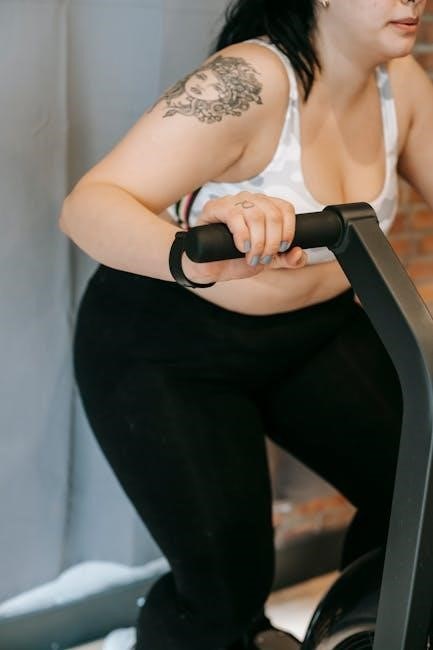Proper bike sizing is crucial for women cyclists, ensuring comfort, performance, and safety. This guide covers frame sizes, women-specific designs, and professional fitting for optimal cycling experiences.
Understanding the Importance of Proper Bike Sizing
Proper bike sizing is essential for women cyclists, optimizing comfort, efficiency, and safety. A well-fitted bike reduces fatigue and injury risks, enhancing performance. Incorrect sizing can lead to discomfort or control issues. Understanding frame size, saddle fit, and handlebar width ensures a tailored experience, making every ride enjoyable and safe.
Overview of Women’s Bike Size Charts
Women’s bike size charts provide a structured guide to help determine the ideal frame size based on height, inseam, and body proportions. These charts vary by bike type, such as road, mountain, or hybrid, and often include specific measurements for standover clearance and reach. They cater to women-specific designs, offering tailored fits for comfort and performance. Charts may differ slightly between brands, emphasizing the importance of consulting manufacturer guides for accuracy.

Factors Affecting Women’s Bike Size
Height, inseam, body proportions, and riding style are key factors in determining the right bike size for women, ensuring a comfortable and efficient cycling experience.
Height and Inseam Measurements
Height and inseam are critical for determining women’s bike size. Height helps estimate frame size, while inseam ensures proper standover clearance. Measure inseam from the floor to crotch. Bikes are sized to fit various heights, with inseam adjustments ensuring safety and comfort. Professional fittings and test rides are recommended for accuracy, as sizing can vary by brand and bike type.
Body Proportions and Riding Style
Body proportions and riding style significantly impact bike fit for women. Torso length, arm reach, and flexibility influence handlebar and stem choices. Riding style—whether aggressive or upright—affects saddle height and handlebar type. Women-specific bikes often feature shorter reach and narrower handlebars to accommodate female body proportions. Test riding ensures the bike matches your body and riding preferences, optimizing comfort and performance.
Types of Bikes and Their Specific Sizing
Women’s bikes vary in sizing based on type, such as road, mountain, or hybrid. Road bikes often feature smaller frames and narrower handlebars, while mountain bikes prioritize standover clearance and robust frames. Hybrid bikes offer a balanced fit for casual riding. Each type requires specific measurements to ensure optimal comfort and performance, making it essential to consider your riding style and preferences when selecting a bike.
Women’s Bike Size Chart Detailed Overview
A detailed guide correlating height, inseam, and frame size for women, ensuring proper fit and comfort. Charts vary by brand, emphasizing the need for professional fitting.
Standard Frame Size Ranges for Women
Women’s bike frames typically range from XXS to L, catering to various heights and body proportions. Sizes correlate with height, inseam, and reach, ensuring optimal fit. For example, a 5’1″ to 5’9″ rider might fit sizes XS to M. However, sizing varies by brand and bike type, emphasizing the importance of professional fitting for accuracy and comfort.
Correlating Height to Frame Size
Height is a primary factor in determining women’s bike frame size. Riders typically fall into size categories based on their height, with specific ranges for each frame size. For example, a 5’3″ to 5’7″ rider often fits a medium frame. However, inseam and reach also influence fit, so height alone isn’t always sufficient. Consulting manufacturer size charts and professional fitting ensures the most accurate match for optimal comfort and performance.
Adjustments Based on Inseam and Reach
Inseam and reach are critical for fine-tuning bike fit. Inseam determines standover clearance, ensuring safety and comfort, while reach affects handlebar placement and riding posture. Measure inseam from the floor to the crotch and compare it to the bike’s standover height. Adjust the saddle height and handlebars based on reach to achieve an optimal riding position, ensuring efficiency and comfort during rides.
Choosing the Right Bike Type
Selecting the right bike type involves considering riding style, terrain, and personal comfort. Road, mountain, and hybrid bikes offer unique features tailored to specific needs and preferences.
Road Bikes: Size and Fit Considerations
Road bikes for women are designed with shorter frames and narrower handlebars to accommodate female physiology. Frame size is determined by height and inseam, ensuring proper standover clearance. Handlebar width should match shoulder width for comfort. Professional fitting is recommended to optimize reach and saddle height, enhancing performance and reducing fatigue. Always consult manufacturer size charts, as sizing can vary between brands.
Mountain Bikes: Size and Fit Considerations
Mountain bikes for women require careful sizing to ensure control and comfort on trails. Standover clearance is critical for maneuverability, while handlebar width should match shoulder width for stability. Seat height and suspension adjustment are key for optimal performance. Testing different models and brands is essential, as sizing varies. Professional fitting can help fine-tune the bike to rider preferences, ensuring a safe and enjoyable off-road experience.
Hybrid and City Bikes: Size and Fit Considerations
Hybrid and city bikes prioritize comfort and practicality, with sizing based on height and inseam. Upright handlebars reduce neck strain, while wider tires offer stability. Ensure saddle height allows slight leg bend and handlebar reach feels natural. Test riding is crucial, as sizing varies by brand. Accessories like racks or fenders may affect fit, so consider these when choosing your bike for daily commuting or casual rides.
Measuring Yourself for the Perfect Fit
Accurate measurements are key to finding the right bike. Use a tape measure to record height and inseam. Stand against a wall with cycling shoes on for precise inseam measurement.
How to Measure Your Height Accurately
Stand against a wall with feet flat, shoulders relaxed, and head level. Use a tape measure or ruler to record height in inches or centimeters. Ensure accuracy by measuring without shoes. For precise results, ask a friend to help or use a height-measuring tool. This measurement is essential for correlating with bike size charts and ensuring a proper fit. Consistency is key for accurate sizing.
Measuring Inseam for Standover Clearance
To measure inseam, stand against a wall with feet flat. Place a hardback book between your legs, snug against your crotch. Measure the height of the book’s top edge using a ruler or tape measure. This provides your inseam length, crucial for determining standover clearance. Proper inseam ensures safe straddling of the bike and optimal fit. Record this measurement accurately for bike sizing charts.
Assessing Reach and Handlebar Fit
Proper reach and handlebar fit are essential for comfort and control. Standover clearance and saddle height ensure a slight bend in the elbows. Handlebars should be shoulder-width for stability and breathing ease. Women-specific bikes often feature narrower bars to accommodate smaller shoulders. Test riding helps confirm optimal reach and fit, reducing fatigue and discomfort during rides. Professional fitting can further refine these adjustments for a personalized experience.
Understanding Frame Size and Geometry
Frame size and geometry are tailored to women’s proportions, offering optimal comfort and efficiency. Women-specific designs feature shorter frames and wheel size options for better fit and control.
Frame Size vs. Wheel Size
Frame size and wheel size are closely related but distinct factors in bike fit. Women’s bikes often use standard 700C wheels, but shorter riders may prefer 650C for better fit. Frame size determines standover height and reach, while wheel size affects handling and rolling efficiency. Proper sizing ensures comfort and control, with smaller wheels offering easier maneuverability for shorter riders. Always prioritize frame fit over wheel size for optimal performance.
Women-Specific Design Features
Women-specific bikes are tailored to accommodate female anatomy, with shorter reach, narrower handlebars, and smaller grips for better control. Saddles are designed for comfort, reducing pressure points. These bikes often feature lighter frames and adjusted geometry to suit women’s proportions, enhancing comfort and efficiency without compromising performance. These designs ensure a more natural riding position, catering to the unique needs of women cyclists.
Importance of Standover Height
Standover height is crucial for safety and comfort, ensuring there’s enough clearance between the rider and the bike frame. Proper standover height prevents injury in case of a fall and allows for better control. It’s measured from the ground to the top tube and varies by bike type. Adequate clearance enhances confidence and riding stability, making it a key factor in women’s bike sizing for optimal safety and performance.

Handlebar and Wheel Size Considerations
Narrower handlebars suit women’s shoulder widths, enhancing control. Wheel sizes like 700C or 650C cater to rider height and terrain, ensuring optimal fit and comfort.
Narrower Handlebars for Women
Narrower handlebars are designed to fit women’s shoulder widths, improving control and comfort; Women-specific bikes often feature slimmer bars to accommodate shorter reach and narrower shoulders. This design ensures better ergonomics, reducing strain on the neck and shoulders. Proper handlebar fit is crucial for long rides, enhancing overall cycling efficiency and enjoyment. Always consider handlebar width when selecting a bike for optimal performance.
Wheel Size Options for Different Riders
Wheel size options vary to suit different riders, with 700C (622mm) being standard for road bikes, while smaller riders may prefer 650C (571mm) for better fit. Women-specific bikes often use these sizes to ensure optimal geometry and comfort. Wheel size impacts handling and efficiency, so it’s essential to choose based on height and riding style. Always consult manufacturer guides and test ride to confirm the best fit for your needs.
Impact of Wheel Size on Bike Fit
Wheel size significantly impacts bike fit, with 700C (622mm) being standard for road bikes, offering better efficiency, while 650C (571mm) suits shorter riders, lowering standover height. Proper wheel size ensures optimal geometry, comfort, and control. It affects handling, stability, and maneuverability, making it crucial to choose based on height and riding style. Correct wheel size enhances overall performance and riding experience for women cyclists.
Brand-Specific Sizing Variations
Women’s bike sizes vary across brands due to differences in frame geometry and design. Always consult the manufacturer’s size guide for accurate fit and optimal performance.
Why Sizes Vary Across Brands
Women’s bike sizes differ across brands due to varying frame geometries, women-specific designs, and unique sizing standards. Some brands cater to shorter reaches and narrower handlebars, while others prioritize comfort through ergonomic designs. Additionally, wheel size and standover height can influence frame sizing. Always consult the manufacturer’s size guide, as a “medium” can vary significantly between brands. Professional fitting is recommended for the best fit.
Popular Women’s Bike Brands and Their Sizing
Brands like Trek, Liv, Specialized, and Cannondale offer women-specific bikes with tailored sizing. Trek’s frames cater to shorter torsos, while Liv bikes feature narrower handlebars. Specialized offers a wide range of sizes, and Cannondale focuses on ergonomic designs. Each brand’s sizing chart varies, so consulting the manufacturer’s guide is essential for the best fit. These brands prioritize comfort and performance for women riders of all sizes.
Checking Manufacturer Size Guides
Always consult the manufacturer’s size guide for accurate fitting, as sizing varies between brands. Trek, Liv, and Specialized provide detailed charts tailored to their frames. These guides often include height, inseam, and frame size correlations. Using the manufacturer’s specific sizing ensures a better fit, as generic charts may not account for brand-specific geometries. Referencing these guides helps riders choose the correct size for optimal comfort and performance.

Professional Bike Fitting
A professional bike fit ensures optimal comfort, efficiency, and performance by tailoring the bike to the rider’s unique body proportions and riding style, enhancing overall cycling experience.
Benefits of a Professional Fit Session
A professional bike fit ensures optimal comfort, efficiency, and performance by tailoring the bike to the rider’s unique body proportions and riding style. It reduces fatigue, prevents injuries, and enhances control. Experienced fitters adjust saddle height, handlebar reach, and cleat position for a personalized fit, making every ride more enjoyable and effective. This session is especially valuable for women, as it accounts for specific anatomical needs and riding preferences.
What to Expect During a Bike Fit
A professional bike fit begins with a pre-fit interview to discuss your riding style, goals, and any discomfort. The fitter then analyzes your bike setup, adjusting saddle height, handlebar reach, and cleat position. A dynamic fit on the bike ensures optimal pedaling efficiency and comfort. The session concludes with a review of adjustments and personalized recommendations to enhance your cycling experience, tailored to your specific needs as a woman rider.

Cost and Value of Professional Fitting
Professional bike fitting typically costs between $100 to $300, depending on the shop and services offered. The session includes detailed measurements, bike adjustments, and personalized recommendations. While it may seem like an extra expense, a proper fit enhances comfort, efficiency, and safety, making it a valuable investment for women cyclists. Many shops also offer discounts on bike purchases after a fitting, adding to its overall value.

Test Riding and Final Adjustments
Test riding ensures the bike feels right, allowing adjustments for optimal comfort and performance. Final tweaks, like saddle height and handlebar position, guarantee a perfect fit.
Importance of Test Riding
Test riding is essential to ensure a bike feels right, allowing you to assess comfort, handling, and performance. It provides an opportunity to make necessary adjustments for optimal fit. By testing different models, you can compare how each bike responds to your riding style. Start with a short ride to evaluate ergonomics and control. This step ensures the bike aligns with your body and preferences, making cycling more enjoyable and efficient.
Adjusting the Bike for Optimal Comfort
Adjusting a bike for optimal comfort involves fine-tuning key components. Saddle height and position should align with your riding style, ensuring proper leg extension and comfort. Handlebar height and width can be modified to reduce strain on your neck and shoulders. Additionally, seatpost and stem adjustments can improve reach and posture. These tweaks ensure a personalized fit, enhancing both performance and comfort during rides.

Final Checks Before Purchase
Before finalizing your purchase, ensure the bike fits perfectly and meets your needs. Test ride the bike to confirm comfort and handling. Check the saddle height, handlebar alignment, and overall geometry. Verify that the frame size and components match your riding style. Consult with a professional fitter if needed, and ensure all adjustments are made for optimal performance and comfort. This step ensures your bike is tailored to you.

Common Mistakes to Avoid
- Relying solely on size charts without professional fitting.
- Overlooking the importance of test riding different bike types.
- Not considering brand-specific sizing variations.
Incorrectly Relying on Size Charts
Relying solely on size charts can lead to poor fit, as sizes vary across brands and models. While charts provide a starting point, they don’t account for individual geometry or riding style. Professional fitting and test rides are essential for ensuring optimal comfort and performance, as they address unique factors like reach, standover height, and handlebar alignment.

Overlooking Professional Fit Benefits
Overlooking professional bike fitting can result in a poor fit, leading to discomfort and reduced performance. A professional fit ensures personalized adjustments, optimizing saddle height, handlebar reach, and pedal alignment. This expertise tailors the bike to your body, enhancing comfort, efficiency, and safety. While size charts are helpful, they don’t account for individual differences, making a professional fit invaluable for achieving the best riding experience.
Not Testing Different Bike Types
Not testing different bike types can lead to discomfort, poor performance, and even injury. Each bike type—road, mountain, or hybrid—is designed for specific needs. Test riding ensures the bike matches your riding style and preferences. Relying solely on size charts may overlook personal fit nuances. Always test ride various models to make an informed decision and ensure optimal comfort and efficiency.

Maintenance and Adjustments Post-Purchase
Regular maintenance ensures optimal performance and longevity. Adjustments may be needed as riding habits evolve, and upgrading components can enhance fit and comfort over time.
Regular Bike Maintenance Tips
Regular maintenance is essential to ensure your bike remains in optimal condition. Clean the frame and components frequently, lubricate the chain, and check tire pressure before rides. Inspect brakes and gears for proper function, and replace worn parts promptly. Store your bike in a dry place to prevent rust. Schedule professional tune-ups annually to address any issues early. Consistent upkeep enhances performance, safety, and longevity of your bike.
Adjusting Fit as Your Riding Changes
As your riding style or body proportions change, it’s important to reassess your bike fit. Regularly check saddle height, handlebar reach, and gear setup to ensure comfort and efficiency. If you start riding longer distances or switch to a different type of cycling, consider professional adjustments. Small tweaks can make a big difference in performance and comfort, ensuring your bike continues to suit your evolving needs over time.
Upgrading Components for Better Fit
Upgrading bike components can significantly enhance comfort and performance. Consider replacing handlebars, saddles, or stems to better suit your body proportions. Narrower handlebars or a women-specific saddle can improve fit. Adjusting crank length or pedal placement may also help. Always consult a professional to ensure upgrades align with your riding style and maintain optimal bike functionality for a personalized and efficient cycling experience.
